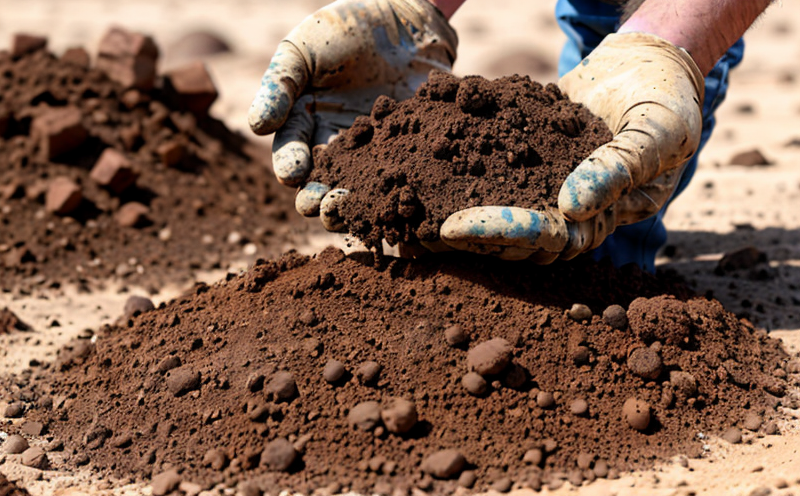BS 1377 Part 7 Shear Strength Tests of Soils
The British Standard 1377 Part 7 specifies methods for determining the shear strength of soils by direct shear testing. This method is widely used in geotechnical engineering to assess the stability and behavior of soil under various loading conditions, particularly during excavation or construction projects.
This test is crucial in mining operations where the stability of overburden materials plays a significant role in ensuring safe and efficient extraction processes. The shear strength of soils determines how much load a given volume of soil can withstand before it begins to slide or deform. Accurate measurement ensures that structures, such as retaining walls and mine shafts, are designed with sufficient capacity to handle the expected loads.
The direct shear test involves placing a sample of soil in a shear box, applying vertical pressure (normal stress) and then shearing the sample by moving one face of the box at a constant rate until failure occurs. The frictional resistance offered by the soil during this process is measured as the shear strength.
For accurate results, it’s essential to follow BS 1377 Part 7 meticulously. This includes ensuring that the specimens are prepared correctly and that all equipment used in testing meets the specified standards. The quality of preparation can significantly influence the outcome of the test; hence, precise handling is critical.
The test parameters include various soil types such as sands, gravels, clays, silts, and organic soils. Each type behaves differently under stress, which influences its shear strength. Understanding these differences allows for more accurate predictions of how the soil will behave in real-world conditions.
Specimen preparation is another critical aspect of this testing method. Soil samples are collected from the site, sieved to remove unwanted particles, and then compacted into cylindrical specimens with a specified diameter and height. The compaction process ensures that each specimen has uniform density, which is essential for accurate shear strength measurements.
Instrumentation plays a vital role in this testing method. High-precision equipment such as load cells, displacement meters, and data acquisition systems are used to measure the normal stress applied to the soil specimens and the resulting shear stresses at various stages of loading. These instruments provide real-time data that helps in monitoring the test process accurately.
The results obtained from these tests are then analyzed using standard procedures outlined in BS 1377 Part 7. This analysis involves plotting the shear stress against normal stress to obtain a strength envelope, which represents the maximum capacity of the soil sample at different levels of applied stress.
Compliance with this British Standard is crucial for ensuring that mining operations meet regulatory requirements and industry best practices. The results from these tests can be used in various ways, including designing safe working conditions, planning excavation procedures, and selecting appropriate materials for support structures.
In conclusion, the BS 1377 Part 7 shear strength test is a fundamental tool in geotechnical engineering, providing critical information about soil behavior that is essential for successful mining operations. By adhering to this standard, laboratories ensure accurate and reliable results, contributing significantly to operational safety and efficiency.
Industry Applications
The BS 1377 Part 7 shear strength test finds extensive application in the mining sector due to its ability to assess the stability of overburden materials. This is particularly important during excavation processes where understanding soil behavior under stress can prevent potential hazards and minimize risks.
- Excavation Planning: Knowing the shear strength of soils helps in planning safe excavation depths and slopes, reducing the risk of landslides or collapses.
- Support Design: The test results are used to design retaining walls and other support structures that can withstand expected loads without failure.
- Risk Assessment: By evaluating soil stability, risks associated with mining operations can be identified and mitigated effectively.
The data obtained from these tests also supports decision-making processes related to the selection of appropriate materials for construction purposes. This ensures that the chosen materials are capable of supporting the intended loads safely.
Furthermore, compliance with this standard is mandatory in many countries as part of regulatory requirements. This helps ensure uniformity and consistency across different projects worldwide, promoting best practices and enhancing safety standards.
Customer Impact and Satisfaction
The use of BS 1377 Part 7 shear strength tests significantly impacts customer satisfaction by ensuring that mining operations are conducted safely and efficiently. Accurate assessment of soil stability through these tests provides critical insights into potential risks, enabling proactive measures to be taken before they escalate into hazards.
Customers benefit from the peace of mind provided by knowing that their projects are being managed according to recognized standards. This not only enhances reputation but also builds trust within the industry and among stakeholders.
The reliability of test results is paramount in maintaining customer satisfaction. By adhering strictly to the procedures outlined in BS 1377 Part 7, laboratories ensure that their findings accurately reflect the true condition of the soil samples being tested. This accuracy is crucial for making informed decisions regarding project design and execution.
Moreover, compliance with this standard helps customers meet regulatory requirements, thereby avoiding costly penalties or delays associated with non-compliance. It also demonstrates a commitment to ethical practices, which is increasingly important in today’s competitive market environment.
International Acceptance and Recognition
- ISO 14688: This international standard provides guidelines on the determination of shear strength using direct methods. It is aligned with BS 1377 Part 7.
- ASTM D3059: Developed by the American Society for Testing and Materials, this method specifies procedures for determining the unconfined compressive strength of cohesive soils.
- EN 1997-2: This European standard outlines design methods for buildings in terms of geotechnical aspects. It includes provisions relevant to soil shear strength testing similar to BS 1377 Part 7.
The acceptance and recognition of these standards across various countries underscore their importance and reliability in the field of geotechnical engineering. Laboratories that adopt these practices ensure compatibility with global benchmarks, facilitating smoother international collaboration and trade.





